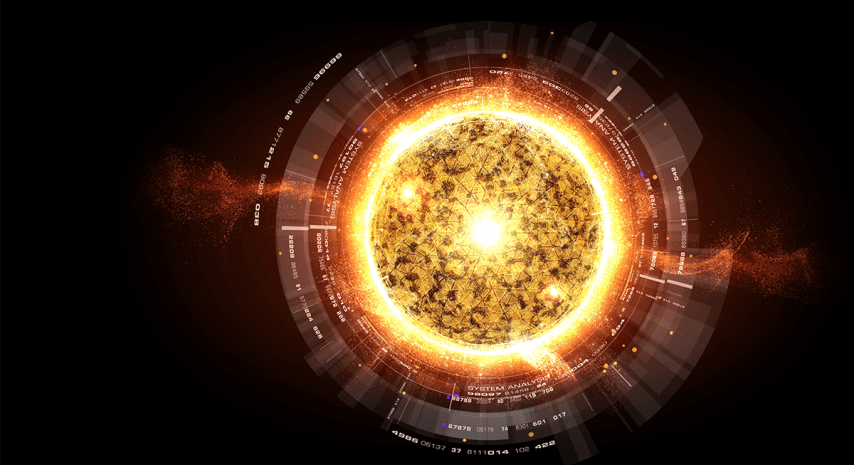Introduction: China’s Artificial Sun – A Game-Changer in Clean Energy
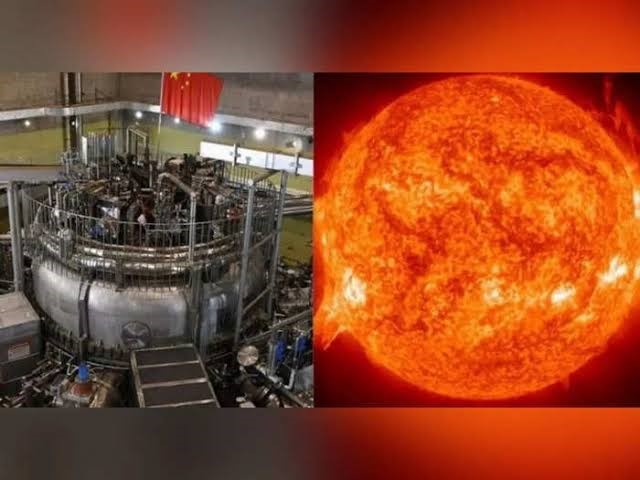
In a groundbreaking scientific achievement, China’s Artificial Sun has emerged as one of the most ambitious and revolutionary advancements in the field of nuclear fusion energy. Officially known as the Experimental Advanced Superconducting Tokamak (EAST), this cutting-edge fusion reactor has set new global benchmarks by sustaining temperatures over 150 million degrees Celsius—nearly ten times hotter than the core of the real sun. With the world actively searching for sustainable and renewable energy solutions, China’s fusion energy project presents a bold step toward an unlimited clean energy future, capable of reducing dependence on fossil fuels and mitigating the effects of climate change.
The Need for an Artificial Sun: Addressing the Global Energy Crisis
The global energy crisis has intensified in recent years due to the rapid depletion of fossil fuel reserves, increasing energy demands, and the urgent need to combat carbon emissions. Traditional sources such as coal, oil, and natural gas have led to significant environmental degradation, contributing to global warming and extreme climate conditions. Renewable energy sources like solar, wind, and hydroelectric power have made progress, but they still face limitations related to efficiency, storage, and scalability.
This is where nuclear fusion technology comes into play. Unlike nuclear fission, which powers conventional nuclear reactors and produces radioactive waste, nuclear fusion replicates the natural process that powers the sun and stars, merging hydrogen atoms to release massive amounts of clean, sustainable, and nearly limitless energy. The idea of building an artificial sun on Earth aims to harness this fusion energy and revolutionize the way the world generates electricity.
China’s Vision Behind the Artificial Sun Project
China has positioned itself as a global leader in the pursuit of nuclear fusion energy, investing billions of dollars into research and development to achieve the ultimate goal of commercial fusion power. The EAST reactor, located in Hefei, Anhui Province, is part of China’s broader plan to accelerate breakthroughs in fusion technology and contribute to the global shift toward carbon neutrality.
The success of China’s artificial sun project is not only a scientific milestone but also a geopolitical and economic game-changer. If fully realized, fusion energy could reshape global energy markets, reduce reliance on fossil fuels, and position China at the forefront of the clean energy revolution. With international collaborations—including partnerships with the International Thermonuclear Experimental Reactor (ITER) and other global research institutions—China is paving the way for a future where fusion power plants could supply clean energy to millions worldwide.
What Lies Ahead?
As research progresses, scientists are optimistic that nuclear fusion energy could become a reality within the next few decades. While challenges such as high operational costs, energy efficiency, and plasma containment remain, the breakthroughs achieved by China’s artificial sun bring us one step closer to an era where humanity can harness the power of the stars for a sustainable future.
1. Understanding the Concept of an Artificial Sun
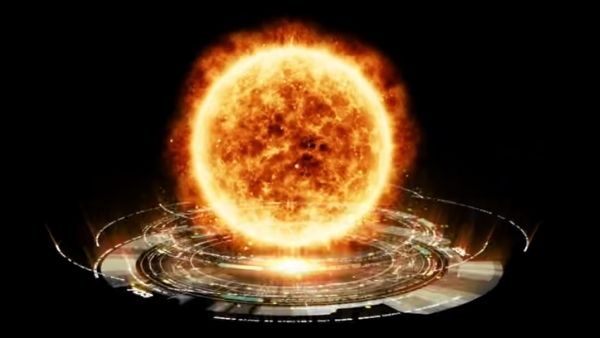
As the world seeks sustainable alternatives to traditional energy sources, China’s Artificial Sun has captured global attention for its potential to revolutionize energy production. But what exactly is an artificial sun, and how does it work? At its core, this ambitious project aims to replicate the natural process of nuclear fusion, the same energy source that powers the real sun and stars.
By creating an environment where hydrogen atoms fuse to generate massive amounts of clean energy, China’s fusion energy project could unlock an unlimited, sustainable power source—one that could significantly reduce reliance on fossil fuels and combat climate change.
What is an Artificial Sun?
The term artificial sun refers to an advanced nuclear fusion reactor designed to produce energy in a way that mimics the natural fusion process occurring in the sun. Unlike traditional nuclear fission reactors, which split heavy atoms like uranium, nuclear fusion works by combining light atomic nuclei, such as hydrogen isotopes (deuterium and tritium), to form helium while releasing an enormous amount of energy.
The key advantage of fusion energy is that it generates zero carbon emissions, produces minimal radioactive waste, and offers an almost limitless supply of fuel, as hydrogen is abundantly available in water. This makes nuclear fusion one of the most promising clean energy solutions of the future.
The Science Behind Nuclear Fusion and Plasma Physics
At the heart of China’s artificial sun project is the tokamak, a magnetic confinement device that uses high-powered magnetic fields to contain a superheated plasma state of matter. Plasma is an ionized gas in which electrons are stripped from atomic nuclei, allowing nuclear fusion to occur under extreme temperatures and pressure conditions.
To achieve nuclear fusion, the EAST (Experimental Advanced Superconducting Tokamak) reactor must heat plasma to over 150 million degrees Celsius—nearly ten times hotter than the core of the sun. At such extreme temperatures, hydrogen isotopes collide with enough force to overcome their natural electrostatic repulsion, allowing them to merge and release massive amounts of energy.
This energy, if harnessed successfully, could be used to generate electricity on a large scale, providing a reliable and sustainable alternative to fossil fuels.
How China’s Artificial Sun Differs from Nuclear Fission
It is essential to distinguish nuclear fusion from nuclear fission, which powers traditional nuclear reactors. While both processes involve atomic reactions, they operate in fundamentally different ways:
Feature Nuclear Fission (Traditional Reactors) Nuclear Fusion (Artificial Sun) Process Splits heavy atoms (e.g., uranium) Fuses light atoms (e.g., hydrogen) Energy Output High but limited Extremely high and nearly limitless Radioactive Waste Produces long-lived waste Minimal short-lived waste Safety Risks Risk of meltdown or explosion No risk of catastrophic meltdown Fuel Availability Limited uranium supply Abundant hydrogen in water Environmental Impact Carbon-free but generates nuclear waste Clean, safe, and sustainable
With these advantages, China’s artificial sun has the potential to become a game-changer in clean energy production, offering a safe, sustainable, and highly efficient alternative to current power generation methods.
The Role of Plasma in Fusion Reactions
To sustain nuclear fusion, the EAST reactor must create and maintain a stable plasma state—a highly energized form of matter where electrons and ions move freely. Achieving and controlling this plasma requires advanced magnetic confinement technology, ensuring that the superheated gas doesn’t touch the reactor walls, which would cause energy loss and damage.
China’s fusion energy project has made significant progress in controlling plasma, with the EAST reactor successfully maintaining plasma temperatures above 150 million degrees Celsius for over 17 minutes, setting a world record. This breakthrough brings humanity one step closer to achieving sustained nuclear fusion as a viable energy source.
2. Explore China’s Breakthrough in Nuclear Fusion Technology
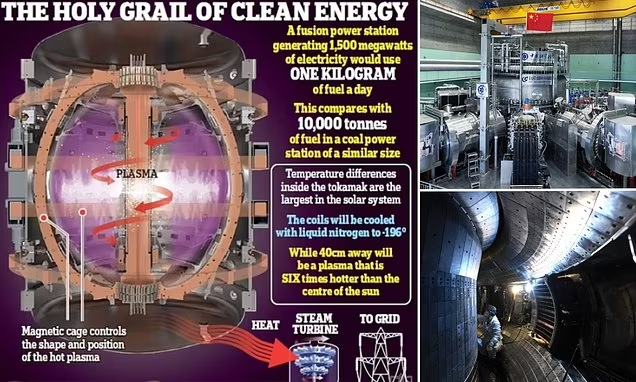
China’s ambitious quest to harness nuclear fusion energy has positioned it as a global leader in the development of artificial sun technology. With the successful operation of the Experimental Advanced Superconducting Tokamak (EAST), China has achieved groundbreaking milestones that bring the world one step closer to unlocking a future powered by clean, unlimited energy.
As the world grapples with the climate crisis and the need for sustainable energy solutions, China’s advancements in fusion energy technology demonstrate the immense potential of artificial sun projects to revolutionize global power generation.
China’s Major Achievements in Nuclear Fusion
The EAST reactor, located in Hefei, Anhui Province, has set multiple world records for sustaining ultra-high temperatures, proving that fusion power is not just theoretical but a viable future energy source. Some of the most notable breakthroughs include:
- December 2021: EAST achieved a record temperature of 70 million degrees Celsius for 1,056 seconds (nearly 17.6 minutes).
- May 2021: The reactor sustained plasma temperatures of 120 million degrees Celsius for 101 seconds.
- 2020: EAST maintained plasma at 100 million degrees Celsius for 20 seconds, demonstrating the ability to sustain extreme conditions.
These achievements mark significant progress in magnetic confinement fusion—a critical component of sustaining and controlling plasma for extended periods, a key requirement for practical fusion power plants.
The Experimental Advanced Superconducting Tokamak (EAST): China’s Artificial Sun
The EAST tokamak is at the heart of China’s nuclear fusion research, operating as an experimental platform to push the limits of fusion plasma containment. The main goal of EAST is to test and refine technologies that will be implemented in future commercial nuclear fusion reactors.
How EAST Works
- Superheating Plasma: Using powerful magnetic fields, hydrogen isotopes (deuterium and tritium) are heated to over 150 million degrees Celsius, creating an environment where nuclear fusion occurs.
- Magnetic Confinement: The tokamak design uses magnetic coils to keep the plasma from touching the reactor walls, preventing heat loss and maintaining stability.
- Energy Release: When hydrogen atoms fuse, they release enormous amounts of energy, which could be converted into electricity in future fusion power plants.
EAST is often referred to as China’s artificial sun because it replicates the same nuclear fusion process that powers the real sun, albeit on a controlled, smaller scale.
China’s Role in the Global Nuclear Fusion Race
While China’s artificial sun project has set impressive records, it is not the only country investing in fusion energy research. The global race for nuclear fusion includes projects like:
- ITER (International Thermonuclear Experimental Reactor): A multinational project based in France, involving China, the EU, India, Japan, South Korea, Russia, and the US, with a goal of producing self-sustained nuclear fusion by 2035.
- MIT and Commonwealth Fusion Systems’ SPARC Project (USA): A compact, high-powered fusion reactor expected to achieve net energy gain by the late 2020s.
- JET (Joint European Torus) – UK: The largest operational tokamak in Europe, which set its own record in 2022 by producing 59 megajoules of energy from fusion reactions.
China’s active participation in ITER, combined with the independent successes of EAST, positions the country as a dominant player in the race to achieve commercial nuclear fusion energy.
How China’s Breakthroughs Bring Us Closer to Fusion Energy
The ultimate goal of China’s artificial sun project is to develop a self-sustaining fusion reaction that generates more energy than it consumes—an achievement known as net energy gain or ignition. If successful, this would pave the way for commercial fusion power plants that could provide clean, limitless energy to the world.
China is already working on the next phase of fusion research:
- CFETR (China Fusion Engineering Test Reactor): This next-generation fusion reactor aims to bridge the gap between experimental tokamaks like EAST and full-scale commercial fusion power plants.
- Fusion-Powered Electricity Generation: Scientists estimate that fusion-based electricity grids could become a reality by 2050, depending on further technological advancements and global collaboration.
The Future of China’s Artificial Sun
China’s fusion energy project is more than just a scientific endeavor—it has the potential to reshape global energy markets, reduce carbon emissions, and provide an alternative to fossil fuels.
While technical challenges remain, including plasma stability, reactor durability, and economic feasibility, the rapid progress in fusion technology is a promising sign that humanity is moving closer to achieving the dream of clean, infinite energy.
3. Explore How China’s Artificial Sun Works
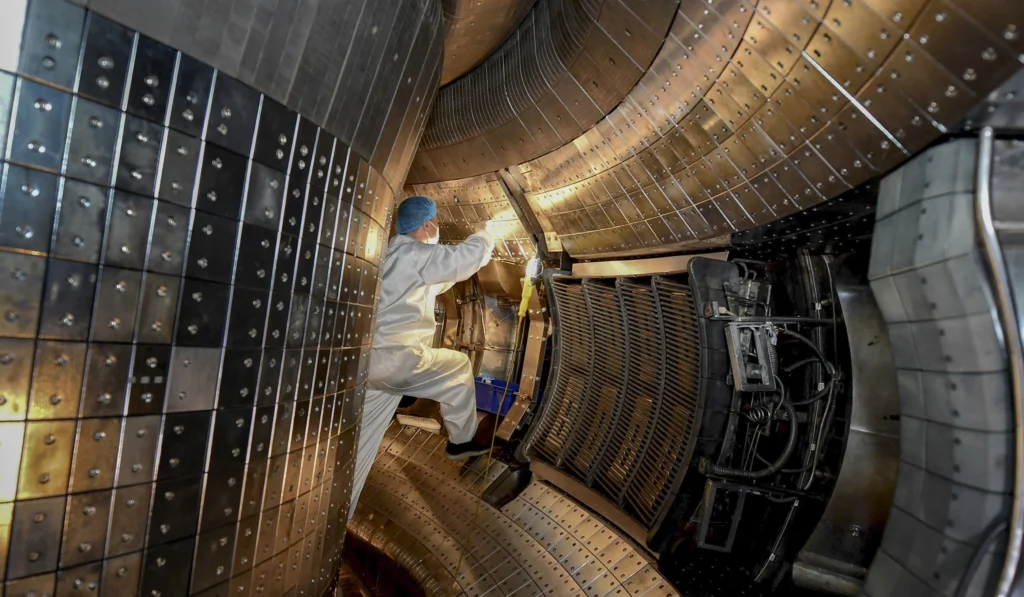
China’s artificial sun project, officially known as the Experimental Advanced Superconducting Tokamak (EAST), is at the forefront of the global race to achieve nuclear fusion energy. But how does this advanced fusion reactor work, and what makes it different from conventional nuclear power plants?
By replicating the same nuclear fusion process that powers the real sun, EAST aims to create a sustainable and limitless clean energy source. Understanding the working mechanism of China’s artificial sun requires breaking down the complex physics, high-temperature plasma control, and magnetic confinement technology behind this revolutionary system.
The Core Principle: Nuclear Fusion Like the Sun
Unlike traditional nuclear fission reactors, which split heavy atoms (like uranium) to release energy, nuclear fusion combines light atomic nuclei, such as hydrogen isotopes (deuterium and tritium), under extreme heat and pressure to form helium. This reaction releases enormous amounts of energy, similar to what happens inside the core of the sun.
Fusion energy is considered the holy grail of clean energy because:
- It produces no greenhouse gases, making it a zero-carbon energy source.
- It generates minimal radioactive waste, unlike nuclear fission.
- The fuel source (hydrogen) is virtually unlimited, as it can be extracted from seawater.
- There is no risk of catastrophic meltdowns, making it much safer than traditional nuclear power.
Key Components of China’s Artificial Sun
To create and control nuclear fusion on Earth, EAST utilizes a tokamak reactor—a doughnut-shaped device that uses magnetic confinement to sustain a superheated plasma state. Here’s how it works:
1. Plasma Generation – Heating Hydrogen to Extreme Temperatures
To initiate fusion, EAST must heat hydrogen plasma to over 150 million degrees Celsius—nearly ten times hotter than the sun’s core. This is done using a combination of:
- Microwave heating: Powerful microwaves excite and heat hydrogen atoms.
- Magnetic compression: High-energy magnets squeeze the plasma, increasing temperature and pressure.
- Neutral beam injection: High-speed particles are injected to transfer energy and maintain plasma conditions.
At these extreme temperatures, hydrogen nuclei move at ultrahigh speeds, colliding with enough force to overcome their natural repulsion, allowing fusion reactions to occur.
2. Magnetic Confinement – Controlling Superheated Plasma
One of the biggest challenges in nuclear fusion technology is containing the plasma, as it can reach temperatures hotter than any known material can withstand. EAST uses powerful superconducting magnets to create a magnetic field cage, preventing the plasma from touching the reactor walls.
This magnetic confinement system ensures:
- Plasma remains suspended and stable within the reactor.
- Heat loss is minimized, maintaining the required high-energy state for fusion.
- The reactor remains safe and efficient by avoiding direct contact between plasma and structural materials.
3. Sustaining Fusion Reactions – Achieving Net Energy Gain
A major milestone for China’s artificial sun project is achieving sustained nuclear fusion, meaning the energy produced by the reaction is greater than the energy used to maintain it. This is known as net energy gain or ignition, and it is the ultimate goal of all fusion energy research.
While EAST has successfully maintained plasma at extreme temperatures for over 17 minutes, the challenge remains to sustain it for hours or days—long enough to make fusion energy commercially viable.
The Road to Commercial Fusion Power
China’s artificial sun project is part of a larger roadmap to develop commercial fusion power plants that could one day supply clean, unlimited electricity to cities worldwide. The next step involves:
- Scaling up EAST’s technology for larger reactors like the China Fusion Engineering Test Reactor (CFETR).
- Collaborating with the International Thermonuclear Experimental Reactor (ITER) to develop the world’s largest fusion reactor in France.
- Improving plasma stability and reactor efficiency to achieve sustained energy production.
If successful, fusion power could replace fossil fuels, significantly reducing carbon emissions and mitigating climate change on a global scale.
4. Explore Potential Benefits of China’s Artificial Sun
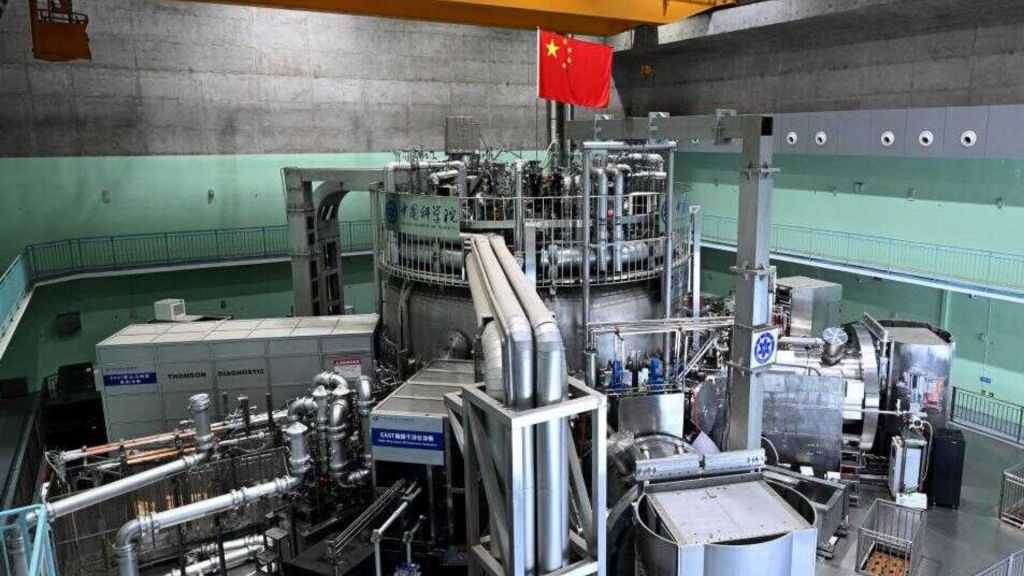
China’s artificial sun project, powered by advanced nuclear fusion technology, represents one of the most promising innovations in the quest for clean, sustainable, and limitless energy. If successful, this revolutionary energy source could transform industries, reshape global power grids, and significantly contribute to climate change solutions. The potential benefits of China’s artificial sun extend far beyond just energy production—this breakthrough could redefine economic, environmental, and scientific landscapes worldwide.
1. A Limitless Source of Clean Energy
One of the most significant advantages of nuclear fusion energy is its virtually unlimited fuel supply. Unlike fossil fuels, which are finite and environmentally damaging, fusion energy is fueled by hydrogen isotopes (deuterium and tritium), which can be extracted from seawater and lithium.
- Abundant Fuel: The Earth has enough deuterium in seawater to power human civilization for millions of years.
- No Resource Wars: Unlike oil and gas, which have led to geopolitical conflicts, fusion fuel sources are widely available and evenly distributed.
This means that if China successfully commercializes artificial sun technology, it could end the world’s dependence on fossil fuels, leading to a more stable and energy-secure future.
2. Zero Carbon Emissions – A Climate-Friendly Energy Solution
Global climate change is driven by greenhouse gas emissions from burning fossil fuels. Unlike coal, oil, and natural gas, nuclear fusion does not produce carbon dioxide (CO₂) or other harmful pollutants.
- Net-Zero Energy Source: China’s fusion power plants could provide electricity without contributing to global warming.
- Eliminates Air Pollution: Unlike coal-fired power plants, fusion reactors do not release sulfur dioxide (SO₂), nitrogen oxides (NOx), or particulate matter, reducing air pollution and improving public health.
As the world moves toward carbon neutrality, China’s artificial sun project could play a leading role in achieving global climate goals.
3. Minimal Radioactive Waste – Safer Than Nuclear Fission
Traditional nuclear fission power plants generate highly radioactive waste, which remains hazardous for thousands of years. In contrast, nuclear fusion reactors like China’s EAST produce:
- No long-lived radioactive waste, making disposal and management easier.
- Minimal radiation hazards, significantly reducing the risks of environmental contamination.
- No nuclear meltdown risks, as fusion reactions automatically stop if any failure occurs.
This makes fusion a far safer and more environmentally responsible alternative to conventional nuclear power.
4. Unparalleled Energy Efficiency – Higher Power Output
China’s artificial sun is designed to replicate the immense power of the real sun, generating far more energy than conventional energy sources. Compared to fossil fuels and even nuclear fission, fusion energy has a much higher energy yield:
- 1 gram of fusion fuel produces as much energy as 8 tons of oil.
- No fuel shortages, as deuterium from seawater is practically inexhaustible.
- Consistent power generation, unlike solar and wind, which depend on weather conditions.
With advancements in tokamak reactors like EAST and future projects such as CFETR (China Fusion Engineering Test Reactor), fusion energy could soon become the most efficient energy source ever developed.
5. Economic Growth and Energy Independence
The successful commercialization of China’s artificial sun would bring massive economic advantages, both domestically and globally. Some of the key impacts include:
- Reduced Energy Costs: Once operational, fusion power plants will be much cheaper to maintain than fossil fuel or nuclear fission plants.
- Job Creation: The nuclear fusion industry will create thousands of jobs in engineering, research, and manufacturing.
- Energy Security: China and other fusion leaders will no longer depend on imported oil and gas, reducing vulnerability to global energy crises.
By pioneering fusion technology, China could position itself as a world leader in next-generation energy solutions, attracting investments and strengthening its global economic influence.
5. Unlocking New Scientific and Technological Frontiers

The breakthroughs made in China’s nuclear fusion research have the potential to accelerate advancements in multiple scientific fields, including:
- Plasma physics and superconducting materials
- Advanced robotics and automation
- Space exploration and interstellar propulsion systems
By pushing the limits of high-temperature plasma control, China’s artificial sun project is opening new doors for scientific discovery, shaping the future of renewable energy and beyond.
7. Global Collaboration for a Sustainable Future
Although China has made significant progress in developing the artificial sun, fusion research is a global effort. Collaborations between:
- China’s EAST and CFETR projects
- The ITER fusion project in France
- US and European fusion programs
…are accelerating the race toward a commercial fusion power plant. A successful fusion breakthrough would provide clean energy not just for China, but for the entire world, making energy sustainability a global reality.
6. Explore Challenges and Limitations of Nuclear Fusion
Despite the groundbreaking advancements in China’s artificial sun project, the journey toward achieving commercial nuclear fusion energy is filled with technical, financial, and scientific hurdles. While nuclear fusion is considered the holy grail of clean energy, scientists and engineers still face significant challenges in making this futuristic energy source commercially viable.
From plasma stability issues to high operational costs, here’s a closer look at the key challenges and limitations of nuclear fusion technology—and what it will take to overcome them.
1. Extreme Temperature and Plasma Control
One of the biggest challenges in nuclear fusion technology is sustaining the high-temperature plasma required for fusion reactions. For fusion to occur, the reactor must reach temperatures of over 150 million degrees Celsius—which is nearly ten times hotter than the sun’s core.
- Maintaining stable plasma is extremely difficult. At such high temperatures, plasma becomes highly unstable, making it challenging to sustain long enough for a net energy gain.
- Risk of plasma disruptions. Even slight instabilities can cause the plasma to lose confinement, leading to sudden collapses and damaging reactor components.
Solution in Progress: Advanced magnetic confinement systems and AI-driven plasma control are being developed to stabilize plasma for extended durations, allowing longer and more efficient fusion reactions.
2. Achieving Net Energy Gain
For nuclear fusion energy to be commercially viable, the energy output must be greater than the energy input required to sustain the reaction. This is known as achieving net energy gain (Q > 1).
- Current fusion reactors consume more energy than they produce. While China’s EAST reactor has sustained plasma at record temperatures, it has not yet reached the point where it generates more energy than it consumes.
- Scaling up to commercial power plants is a major hurdle. Even if fusion reactions are sustained, converting that energy into usable electricity at a commercial scale remains a challenge.
Solution in Progress: Next-generation reactors like CFETR (China Fusion Engineering Test Reactor) aim to improve efficiency and move closer to a self-sustaining fusion reaction.
3. High Operational and Development Costs
Developing and maintaining nuclear fusion reactors is incredibly expensive. The cost of research, high-tech materials, and reactor maintenance presents a major economic challenge.
- Billions of dollars in investments are needed. Projects like China’s EAST and the ITER fusion project in France require continuous funding from governments and private investors.
- Long payback period. Unlike solar or wind energy, which have shorter deployment timelines, fusion power plants may take decades before they become economically viable.
Solution in Progress: Increased international collaboration and private sector investments in fusion technology could help reduce costs and accelerate development.
4. Limited Availability of Fusion Fuel – Tritium Scarcity
While deuterium is abundant in seawater, tritium, another key fuel for nuclear fusion, is rare and expensive to produce. The world’s current supply of tritium is limited, creating a potential bottleneck for large-scale fusion energy production.
- Tritium extraction is costly. Unlike deuterium, tritium is not naturally available in large quantities and must be produced in nuclear reactors, making it expensive.
Sustainable fuel cycles are still in development. Scientists are working on breeder blankets to generate tritium within fusion reactors, but large-scale implementation is still in progress.
Solution in Progress: Advanced breeder reactor designs are being explored to make tritium production self-sustaining in fusion plants.
5. Engineering and Material Challenges
A nuclear fusion reactor operates under extreme conditions, requiring materials that can withstand high temperatures, radiation, and plasma interactions. However, even the most advanced materials degrade over time, posing significant engineering challenges.
- Reactor walls must withstand extreme heat and radiation. Over time, materials erode due to high-energy neutron bombardment, reducing reactor efficiency and lifespan.
- Developing heat-resistant materials is complex. Traditional metals cannot withstand the intense heat and radiation inside a fusion reactor.
Solution in Progress: Researchers are developing advanced alloys, tungsten-lithium coatings, and self-repairing materials to extend reactor lifespan and efficiency.
6. Long Timeline for Commercial Deployment
While China’s artificial sun project has made significant progress, experts estimate that commercial fusion energy may still be decades away. The timeline for transitioning from experimental reactors to fully operational fusion power plants is uncertain due to technical and economic hurdles.
- ong-term commitment. Unlike solar and wind, which can be deployed quickly, fusion technology requires continuous research and testing over several decades.
- Regulatory and safety standards must be established. Fusion power must meet strict safety and environmental regulations before widespread implementation.
Solution in Progress: China, along with ITER and private fusion startups, is working to accelerate research and create a roadmap for commercial fusion deployment within the next few decades. Fusion research requires l
6. Explore Economic and Industrial Impact of China’s Artificial Sun
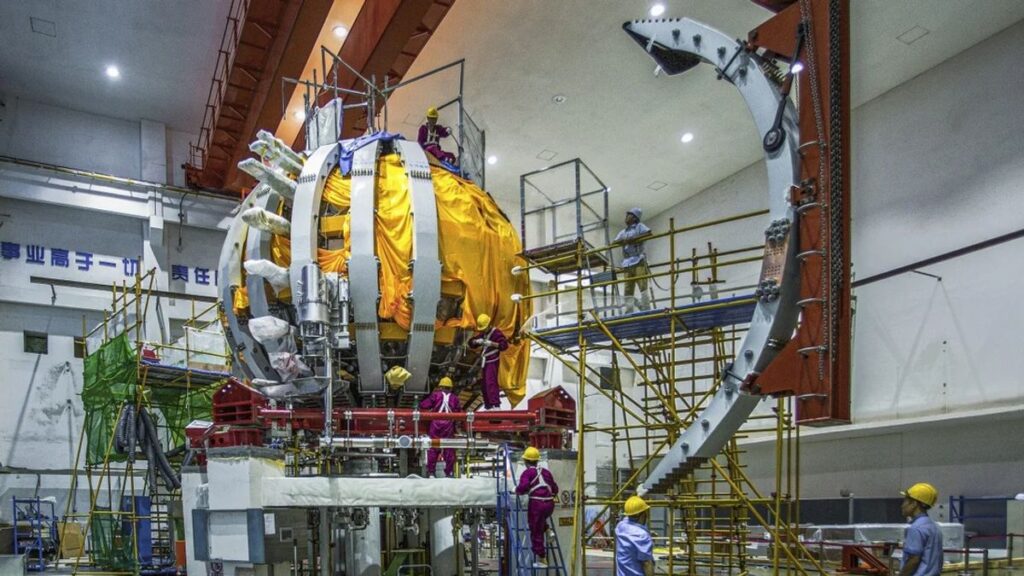
The economic and industrial impact of China’s artificial sun project extends far beyond the realm of energy production. As China pioneers the development of nuclear fusion technology, the global economic landscape stands to undergo a profound transformation. From creating new industries and employment opportunities to reducing dependence on fossil fuels and reshaping global energy markets, the commercialization of fusion energy will drive a massive economic shift.
Let’s explore the key economic and industrial implications of China’s breakthrough in artificial sun technology and how it could reshape the future of global industries, trade, and economic stability.
1. The Rise of a Trillion-Dollar Fusion Energy Industry
The development of commercial fusion power plants could lead to the emergence of a trillion-dollar industry, positioning China as a global leader in next-generation energy solutions. As fusion energy becomes viable, it is expected to:
- Create new markets for fusion-related technologies, including superconductors, advanced materials, and AI-driven energy systems.
- Attract massive investments from both public and private sectors, driving innovation and technological advancements.
- Boost China’s role as a key exporter of fusion technology, allowing it to dominate the global energy market.
Economic Projections: According to industry estimates, the global fusion energy market could be worth over $40 trillion by the end of the century, making it one of the most valuable energy transitions in human history.
2. Job Creation and High-Tech Workforce Expansion
The commercialization of nuclear fusion energy will lead to massive job creation across various industries, particularly in:
- Engineering and Physics: Demand for skilled nuclear engineers, plasma physicists, and AI specialists will skyrocket.
- Manufacturing and Infrastructure: Large-scale construction of fusion power plants will create millions of jobs in advanced manufacturing, robotics, and material sciences.
- Research and Development: Universities and tech institutions will expand research programs, fostering the next generation of fusion scientists and engineers.
China’s artificial sun project is already driving significant employment growth, and as fusion technology scales up, these numbers will multiply, strengthening China’s high-tech economy.
3. Energy Independence and Reduction in Fossil Fuel Dependence
One of the most transformative aspects of China’s nuclear fusion breakthrough is its potential to eliminate dependence on fossil fuels. Fusion energy is virtually limitless, meaning countries that adopt this technology will no longer rely on imported oil, gas, or coal.
- China spends billions annually on fossil fuel imports—a cost that could be significantly reduced with fusion energy.
- Fusion power plants will provide a stable, long-term energy solution, insulating economies from oil price fluctuations and geopolitical tensions.
- Global oil demand will decline, reshaping the petroleum and natural gas industries and accelerating the transition to clean energy sources.
By investing in artificial sun technology, China is securing a sustainable and independent energy future, free from the volatility of global fossil fuel markets.
4. Reshaping Global Energy Markets and Trade
As China advances in fusion energy commercialization, the global energy landscape will experience a major disruption. Traditional energy-exporting nations—such as those in the Middle East, Russia, and the United States—could face economic downturns as demand for fossil fuels declines.
- OPEC countries could see reduced revenues, forcing them to diversify their economies.
- China’s dominance in fusion technology may give it a strategic advantage in global energy negotiations.
- Countries that invest early in fusion energy will benefit from long-term energy cost reductions and increased industrial competitiveness.
China’s artificial sun project could trigger a new geopolitical power shift, with energy independence becoming a major factor in economic and diplomatic relations.
5. Industrial Applications and Technological Advancements
Beyond the energy sector, the breakthroughs in nuclear fusion technology will drive advancements in various industries, including:
- Aerospace & Space Exploration: Fusion-powered propulsion systems could revolutionize interstellar travel, making deep-space missions more feasible.
- Advanced Manufacturing: Fusion research has already led to innovations in superconducting materials, AI-driven plasma control, and heat-resistant alloys.
- Medical Science: High-energy plasma technology from fusion research could enhance cancer treatments, medical imaging, and radiation therapies.
China’s artificial sun is not just an energy breakthrough—it’s a technological catalyst that will fuel scientific progress across multiple fields.
6. Environmental and Climate Economic Benefits
The transition to fusion energy will have immense environmental and economic benefits, leading to:
- Massive reductions in carbon emissions, helping nations meet climate change targets.
- Elimination of energy-related pollution, reducing healthcare costs and improving public health.
- Cost-effective energy solutions, as fusion power plants will eventually become cheaper than fossil fuels.
The global economy currently spends trillions on climate change mitigation—fusion energy could eliminate these costs by providing a 100% clean energy alternative.
7. Explore Global Reactions and Future of Fusion Energy

The development of China’s artificial sun has sparked global discussions about the future of nuclear fusion energy and its potential to revolutionize the world’s energy landscape. As China pushes the boundaries of fusion technology, nations worldwide are responding with their own fusion energy programs, international collaborations, and strategic investments.
The race toward commercial nuclear fusion is no longer just about scientific discovery—it’s about securing energy independence, driving economic growth, and leading the next technological revolution.
Let’s explore the global reactions to China’s artificial sun project and what the future holds for fusion energy on a worldwide scale.
1. International Responses to China’s Artificial Sun
China’s progress in nuclear fusion research has positioned the country as a leader in clean energy innovation, and the world is taking notice. Major global powers, including the United States, European Union, Russia, and Japan, are closely monitoring China’s fusion breakthroughs while accelerating their own fusion energy projects.
- United States: The U.S. Department of Energy (DOE) has increased funding for fusion research, supporting private companies like Helion Energy, Commonwealth Fusion Systems, and TAE Technologies to compete with China’s advancements.
- European Union: The EU remains a key player in fusion energy development through its involvement in ITER (International Thermonuclear Experimental Reactor), the world’s largest fusion project based in France.
- Russia & Japan: Both nations have long-standing fusion research programs, with Russia investing in Tokamak-based fusion reactors and Japan focusing on laser-driven fusion technology.
China’s dominance in the artificial sun project has intensified the global race for fusion supremacy, pushing nations to accelerate innovation and investment.
2. The Role of International Collaboration in Fusion Energy
Despite geopolitical rivalries, nuclear fusion energy remains a field where global cooperation is essential. Large-scale fusion reactors require international expertise, funding, and technological integration, leading to joint research efforts and multinational projects.
Key collaborative efforts include:
- ITER Project (France): A $25 billion international project involving China, the U.S., the EU, Russia, India, Japan, and South Korea—aiming to build the world’s most advanced experimental fusion reactor.
- China’s Cooperation with European Fusion Scientists: China has contributed critical components to ITER, while also developing its own fusion reactor, CFETR (China Fusion Engineering Test Reactor).
- Global Partnerships in AI-Driven Plasma Control: Scientists worldwide are working together to use artificial intelligence (AI) and machine learning to improve plasma stability in fusion reactors.
While competition exists, fusion energy’s complexity makes collaboration a necessity, ensuring that breakthroughs benefit the entire world.
3. How China’s Fusion Breakthrough Impacts Global Energy Policies
With the success of China’s artificial sun, governments worldwide are re-evaluating their energy policies and climate action plans. Fusion energy presents an opportunity to:
- Drastically cut carbon emissions and help countries meet Net Zero 2050 goals.
- Reduce energy dependence on fossil fuels and geopolitically volatile regions.
- Attract investment into clean energy startups and next-generation nuclear technologies.
Countries that prioritize nuclear fusion research today will be the energy leaders of tomorrow, shaping the future of the global power grid.
4. The Future of Commercial Fusion Energy
While China’s artificial sun has achieved remarkable milestones, the path to commercial fusion energy remains challenging. Scientists estimate that commercial-scale fusion reactors may not be fully operational until the 2040s or 2050s. However, with rapid technological advancements, some experts believe fusion energy could arrive much sooner.
- Next-Generation Reactors: China is developing the CFETR, a large-scale fusion reactor expected to bridge the gap between experimental and commercial fusion energy.
- Private Sector Involvement: Companies like Helion Energy, Tokamak Energy, and General Fusion are making breakthroughs in compact fusion reactors, aiming to deliver practical fusion power within the next two decades.
- AI and Supercomputing: Advances in AI-driven plasma stabilization and high-performance computing are accelerating progress toward sustainable fusion reactions.
The future of fusion energy is closer than ever, and China’s artificial sun is playing a pivotal role in making unlimited clean energy a reality.
5. How Fusion Energy Will Transform the World
Once commercial fusion energy becomes a reality, it will lead to:
- Unlimited Clean Energy: Fusion reactors produce zero carbon emissions, offering a sustainable energy source for centuries.
- Global Economic Shifts: Countries investing in fusion now will become energy superpowers, while oil-dependent economies may struggle to adapt.
- Technological Advancements: Fusion research is driving innovation in AI, material sciences, quantum computing, and space exploration.
- Revolutionized Power Grids: The global transition to fusion power plants will reshape the electricity supply industry, making power cheaper and more abundant.
China’s artificial sun project has set the stage for a new era of energy innovation, and as fusion technology evolves, the world will witness one of the most significant energy revolutions in human history.
Explore Conclusion
The development of China’s artificial sun marks a historic breakthrough in the pursuit of limitless, clean energy through nuclear fusion technology. With its ability to generate power by replicating the sun’s energy-producing process, fusion energy has the potential to reshape global energy markets, drive industrial revolutions, and provide a sustainable solution to the world’s growing energy demands.
Over the past decade, China’s advancements in nuclear fusion have positioned the nation as a global leader in energy innovation. The success of Experimental Advanced Superconducting Tokamak (EAST) and ongoing development of the China Fusion Engineering Test Reactor (CFETR) demonstrate China’s long-term commitment to achieving commercial fusion energy. These innovations are not only accelerating scientific progress but also influencing global energy policies, international collaborations, and future economic strategies.
The Global Significance of China’s Artificial Sun
As the world faces climate change challenges, energy crises, and increasing power demands, the need for sustainable energy sources has never been more urgent. China’s artificial sun project is a beacon of hope, showing that fusion power could one day replace fossil fuels, eliminate carbon emissions, and provide an endless source of clean energy.
However, the journey toward commercial nuclear fusion is still ongoing. While major progress has been made in plasma control, energy efficiency, and reactor sustainability, challenges such as high operational costs, scalability issues, and technological limitations remain. Governments, scientific institutions, and private companies must work together to accelerate research, funding, and infrastructure development to bring fusion power into commercial reality.
The Future of Fusion Energy: A New Era of Power Generation
Looking ahead, the successful commercialization of China’s artificial sun and other fusion energy projects will:
- End the world’s dependence on fossil fuels, significantly reducing global carbon emissions.
- Create a multi-trillion-dollar energy industry, driving job creation and economic growth.
- Reshape international energy trade, making countries self-sufficient in clean power.
- Accelerate scientific advancements in AI, quantum physics, space exploration, and medical technologies.
With continued investments, advancements in artificial intelligence (AI), superconductors, and plasma physics, and strengthened global collaborations, fusion energy could become a reality within the next few decades. The race for energy supremacy has begun, and China’s artificial sun is at the forefront of this energy revolution


